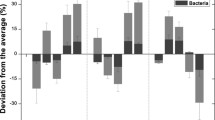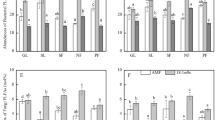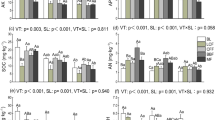Abstract
Soil microorganisms play an important role in the circulation of materials and nutrients between plants and soil ecosystems, but the drivers of microbial community composition and diversity remain uncertain in different vegetation restoration patterns. We studied soil physicochemical properties (i.e., soil moisture, bulk density, pH, soil nutrients, available nutrients), plant characteristics (i.e., Shannon index [HPlant] and Richness index [SPlant], litter biomass [LB], and fine root biomass [FRB]), and microbial variables (biomass, enzyme activity, diversity, and composition of bacterial and fungal communities) in different plant succession patterns (Robinia pseudoacacia [MF], Caragana korshinskii [SF], and grassland [GL]) on the Loess Plateau. The herb communities, soil microbial biomass, and enzyme activities were strongly affected by vegetation restoration, and soil bacterial and fungal communities were significantly different from each other at the sites. Correlation analysis showed that LB and FRB were significantly positively correlated with the Chao index of soil bacteria, soil microbial biomass, enzyme activities, Proteobacteria, Zygomycota, and Cercozoa, while negatively correlated with Actinobacteria and Basidiomycota. In addition, soil water content (SW), pH, and nutrients have important effects on the bacterial and fungal diversities, as well as Acidobacteria, Proteobacteria, Actinobacteria, Nitrospirae, Zygomycota, and microbial biomass. Furthermore, plant characteristics and soil properties modulated the composition and diversity of soil microorganisms, respectively. Overall, the relative contribution of vegetation and soil to the diversity and composition of soil bacterial and fungal communities illustrated that plant characteristics and soil properties may synergistically modulate soil microbial communities, and the composition and diversity of soil bacterial and fungal communities mainly depend on plant biomass and soil nutrients.








Similar content being viewed by others
Data Availability
Some or all data, models, or code generated or used during the study are available from the corresponding author by request.
References
Zhang C, Liu G, Xue S, Wang G (2016) Soil bacterial community dynamics reflect changes in plant community and soil properties during the secondary succession of abandoned farmland in the Loess Plateau. Soil Biology & Biochemistry 97:40–49. https://doi.org/10.1016/j.soilbio.2016.02.013
Zhong Z, Wang X, Zhang X, Zhang W, Xu Y, Ren C, Han X, Yang G (2019) Edaphic factors but not plant characteristics mainly alter soil microbial properties along a restoration chronosequence of Pinus tabulaeformis stands on Mt. Ziwuling, China. Forest Ecology and Management:453. https://doi.org/10.1016/j.foreco.2019.117625
Wu X, Xu H, Tuo D, Wang C, Fu B, Lv Y, Liu G (2020) Land use change and stand age regulate soil respiration by influencing soil substrate supply and microbial community. Geoderma 359:113991. https://doi.org/10.1016/j.geoderma.2019.113991
Blagodatskaya E, Kuzyakov Y (2008) Mechanisms of real and apparent priming effects and their dependence on soil microbial biomass and community structure: critical review. Biology and Fertility of Soils 45:115–131. https://doi.org/10.1007/s00374-008-0334-y
Brockett BFT, Prescott CE, Grayston SJ (2012) Soil moisture is the major factor influencing microbial community structure and enzyme activities across seven biogeoclimatic zones in western Canada. Soil Biology & Biochemistry 44:9–20. https://doi.org/10.1016/j.soilbio.2011.09.003
Ren C, Zhang W, Zhong Z, Han X, Yang G, Feng Y, Ren G (2018) Differential responses of soil microbial biomass, diversity, and compositions to altitudinal gradients depend on plant and soil characteristics. Science of the Total Environment 610:750–758. https://doi.org/10.1016/j.scitotenv.2017.08.110
van der Heijden MGA, Bardgett RD, van Straalen NM (2008) The unseen majority: soil microbes as drivers of plant diversity and productivity in terrestrial ecosystems. Ecology Letters 11:296–310. https://doi.org/10.1111/j.1461-0248.2007.01139.x
Xu M, Lu X, Xu Y, Zhong Z, Zhang W, Ren C, Han X, Yang G, Feng Y (2020) Dynamics of bacterial community in litter and soil along a chronosequence of Robinia pseudoacacia plantations. Science of the Total Environment 703:135613. https://doi.org/10.1016/j.scitotenv.2019.135613
Drenovsky RE, Steenwerth KL, Jackson LE, Scow KM (2010) Land use and climatic factors structure regional patterns in soil microbial communities. Global Ecology and Biogeography 19:27–39. https://doi.org/10.1111/j.1466-8238.2009.00486.x
Prescott CE, Grayston SJ (2013) Tree species influence on microbial communities in litter and soil: current knowledge and research needs. Forest Ecology and Management 309:19–27. https://doi.org/10.1016/j.foreco.2013.02.034
Yang Y, Cheng H, Dou Y, An S (2020) Plant and soil traits driving soil fungal community due to tree plantation on the Loess Plateau. Science of the Total Environment 708:134560. https://doi.org/10.1016/j.scitotenv.2019.134560
Liu J, Yang Z, Dang P, Zhu H, Gao Y, Vu Ngoc H, Zhao Z (2018) Response of soil microbial community dynamics to Robinia pseudoacacia L. afforestation in the loess plateau: a chronosequence approach. Plant and Soil 423:327–338. https://doi.org/10.1007/s11104-017-3516-2
Reinhart KO, Dangi SR, Vermeire LT (2016) The effect of fire intensity, nutrients, soil microbes, and spatial distance on grassland productivity. Plant and Soil 409:203–216. https://doi.org/10.1007/s11104-016-2957-3
Carrino-Kyker SR, Kluber LA, Petersen SM, Coyle KP, Hewins CR, DeForest JL, Smemo KA, Burke DJ (2016) Mycorrhizal fungal communities respond to experimental elevation of soil pH and P availability in temperate hardwood forests. Fems Microbiology Ecology 92. https://doi.org/10.1093/femsec/fiw024
Holste EK, Kobe RK (2017) Tree species and soil nutrients drive tropical reforestation more than associations with mycorrhizal fungi. Plant and Soil 410:283–297. https://doi.org/10.1007/s11104-016-3013-z
Zhou Z, Wang C, Luo Y (2018) Effects of forest degradation on microbial communities and soil carbon cycling: a global meta-analysis. Global Ecology and Biogeography 27:110–124. https://doi.org/10.1111/geb.12663
Gebhardt M, Fehmi JS, Rasmussen C, Gallery RE (2017) Soil amendments alter plant biomass and soil microbial activity in a semi-desert grassland. Plant and Soil 419:53–70. https://doi.org/10.1007/s11104-017-3327-5
Li S, Shakoor A, Wubet T, Zhang N, Liang Y, Ma K (2018) Fine-scale variations of fungal community in a heterogeneous grassland in Inner Mongolia: effects of the plant community and edaphic parameters. Soil Biology & Biochemistry 122:104–110. https://doi.org/10.1016/j.soilbio.2018.04.007
Zhang W, Xu Y, Gao D, Wang X, Liu W, Deng J, Han X, Yang G, Feng Y, Ren G (2019) Ecoenzymatic stoichiometry and nutrient dynamics along a revegetation chronosequence in the soils of abandoned land and Robinia pseudoacacia plantation on the Loess Plateau, China. Soil Biology & Biochemistry 134:1–14. https://doi.org/10.1016/j.soilblo.2019.03.017
Ren C, Zhao F, Shi Z, Chen J, Han X, Yang G, Feng Y, Ren G (2017) Differential responses of soil microbial biomass and carbon-degrading enzyme activities to altered precipitation. Soil Biology & Biochemistry 115:1–10. https://doi.org/10.1016/j.soilbio.2017.08.002
Xu Y, Zhong Z, Zhang W, Han X, Yang G, Ren C, Feng Y, Ren G, Wang X (2019) Responses of soil nosZ-type denitrifying microbial communities to the various land-use types of the Loess Plateau, China. Soil & Tillage Research 195:104378. https://doi.org/10.1016/j.still.2019.104378
Ren C, Zhao F, Kang D, Yang G, Han X, Tong X, Feng Y, Ren G (2016) Linkages of C:N:P stoichiometry and bacterial community in soil following afforestation of former farmland. Forest Ecology and Management 376:59–66. https://doi.org/10.1016/j.foreco.2016.06.004
Zhao F, Zhang L, Ren C, Sun J, Han X, Yang G, Wang J (2016) Effect of microbial carbon, nitrogen, and phosphorus stoichiometry on soil carbon fractions under a black locust forest within the central Loess Plateau of China. Soil Science Society of America Journal 80:1520–1530. https://doi.org/10.2136/sssaj2016.06.0175
Zhang C, Liu G, Xue S, Song Z (2011) Rhizosphere soil microbial activity under different vegetation types on the Loess Plateau, China. Geoderma 161:115–125. https://doi.org/10.1016/j.geoderma.2010.12.003
Liu X, Zhang S (2019) Nitrogen addition shapes soil enzyme activity patterns by changing pH rather than the composition of the plant and microbial communities in an alpine meadow soil. Plant and Soil 440:11–24. https://doi.org/10.1007/s11104-019-04054-5
Zhang W, Ren C, Deng J, Zhao F, Yang G, Tong X, Feng Y, Han X (2018) Plant functional composition and species diversity affect soil C, N, and P during secondary succession of abandoned farmland on the Loess Plateau. Ecological Engineering 122:91–99. https://doi.org/10.1016/j.ecoleng.2018.07.031
Bao S (2000) Soil and agricultural chemistry analysis. China agriculture press, Beijing, China (in Chinese)
Xu Z, Yu G, Zhang X, He N, Wang Q, Wang S, Wang R, Zhao N, Jia Y, Wang C (2017) Soil enzyme activity and stoichiometry in forest ecosystems along the North-South Transect in eastern China (NSTEC). Soil Biology & Biochemistry 104:152–163. https://doi.org/10.1016/j.soilbio.2016.10.020
Caporaso JG, Kuczynski J, Stombaugh J, Bittinger K, Bushman FD, Costello EK, Fierer N, Pena AG, Goodrich JK, Gordon JI, Huttley GA, Kelley ST, Knights D, Koenig JE, Ley RE, Lozupone CA, McDonald D, Muegge BD, Pirrung M, Reeder J, Sevinsky JR, Tumbaugh PJ, Walters WA, Widmann J, Yatsunenko T, Zaneveld J, Knight R (2010) QIIME allows analysis of high-throughput community sequencing data. Nature Methods 7:335–336. https://doi.org/10.1038/nmeth.f.303
Amann RI, Ludwig W, Schleifer KH (1995) Phylogenetic identification and in-situ detection of individual microbial-cells without cultivation. Microbiological Reviews 59:143–169. https://doi.org/10.1128/mmbr.59.1.143-169.1995
Xu L, Ravnskov S, Larsen J, Nilsson RH, Nicolaisen M (2012) Soil fungal community structure along a soil health gradient in pea fields examined using deep amplicon sequencing. Soil Biology & Biochemistry 46:26–32. https://doi.org/10.1016/j.soilbio.2011.11.010
Meier E, Paal J, Liira J, Juriado I (2005) Influence of tree stand age and management on the species diversity in Estonian eutrophic alvar and boreo-nemoral Pinus sylvestris forests. Scandinavian Journal of Forest Research 20:135–144. https://doi.org/10.1080/14004080510042155
Zhang P, Li B, Wu J, Hu S (2019) Invasive plants differentially affect soil biota through litter and rhizosphere pathways: a meta-analysis. Ecology Letters 22:200–210. https://doi.org/10.1111/ele.13181
Spohn M, Kuzyakov Y (2014) Spatial and temporal dynamics of hotspots of enzyme activity in soil as affected by living and dead roots-a soil zymography analysis. Plant and Soil 379:67–77. https://doi.org/10.1007/s11104-014-2041-9
Cui Y, Fang L, Guo X, Wang X, Zhang Y, Li P, Zhang X (2018) Ecoenzymatic stoichiometry and microbial nutrient limitation in rhizosphere soil in the arid area of the northern Loess Plateau, China. Soil Biology & Biochemistry 116:11–21. https://doi.org/10.1016/j.soilbio.2017.09.025
Peng X, Wang W (2016) Stoichiometry of soil extracellular enzyme activity along a climatic transect in temperate grasslands of northern China. Soil Biology & Biochemistry 98:74–84. https://doi.org/10.1016/j.soilbio.2016.04.008
Zhang F-G, Zhang Q-G (2016) Microbial diversity limits soil heterotrophic respiration and mitigates the respiration response to moisture increase. Soil Biology & Biochemistry 98:180–185. https://doi.org/10.1016/j.soilbio.2016.04.017
Canals RM, Mugica L, Duran M, San Emeterio L (2019) Soil bacterial functional diversity mirrors the loss of plant diversity by the expansion of a native tall-grass in high mountain grasslands. Plant and Soil 445:243–257. https://doi.org/10.1007/s11104-019-04281-w
Uibopuu A, Moora M, Oepik M, Zobel M (2012) Temperate forest understorey species performance is altered by local arbuscular mycorrhizal fungal communities from stands of different successional stages. Plant and Soil 356:331–339. https://doi.org/10.1007/s11104-011-1116-0
Xiang X, Gibbons SM, Yang J, Kong J, Sun R, Chu H (2015) Arbuscular mycorrhizal fungal communities show low resistance and high resilience to wildfire disturbance. Plant and Soil 397:347–356. https://doi.org/10.1007/s11104-015-2633-z
Bauer JT, Blumenthal N, Miller AJ, Ferguson JK, Reynolds HL (2017) Effects of between-site variation in soil microbial communities and plant-soil feedbacks on the productivity and composition of plant communities. Journal of Applied Ecology 54:1028–1039. https://doi.org/10.1111/1365-2664.12937
Chen CR, Xu ZH, Blumfield TJ, Hughes JM (2003) Soil microbial biomass during the early establishment of hoop pine plantation: seasonal variation and impacts of site preparation. Forest Ecology and Management 186:213–225. https://doi.org/10.1016/s0378-1127(03)00275-5
Wang K, Zhang Y, Tang Z, Shangguan Z, Chang F, Fa J, Chen Y, He X, Shi W, Deng L (2019) Effects of grassland afforestation on structure and function of soil bacterial and fungal communities. Science of the Total Environment 676:396–406. https://doi.org/10.1016/j.scitotenv.2019.04.259
Merrick MJ, Edwards RA (1995) Nitrogen control in bacteria. Microbiological Reviews 59: 604-&. https://doi.org/10.1128/mmbr.59.4.604-622.1995
Marzluf GA (1997) Genetic regulation of nitrogen metabolism in the fungi. Microbiology and Molecular Biology Reviews 61:17. https://doi.org/10.1128/.61.1.17-32.1997
Barak P, Jobe BO, Krueger AR, Peterson LA, Laird DA (1997) Effects of long-term soil acidification due to nitrogen fertilizer inputs in Wisconsin. Plant and Soil 197:61–69. https://doi.org/10.1023/a:1004297607070
Drenovsky RE, Vo D, Graham KJ, Scow KM (2004) Soil water content and organic carbon availability are major determinants of soil microbial community composition. Microbial Ecology 48:424–430. https://doi.org/10.1007/s00248-003-1063-2
Allison SD, Vitousek PM (2005) Responses of extracellular enzymes to simple and complex nutrient inputs. Soil Biology & Biochemistry 37:937–944. https://doi.org/10.1016/j.soilbio.2004.09.014
Kyaschenko J, Clemmensen KE, Hagenbo A, Karltun E, Lindahl BD (2017) Shift in fungal communities and associated enzyme activities along an age gradient of managed Pinus sylvestris stands. Isme Journal 11:863–874. https://doi.org/10.1038/ismej.2016.184
Funding
Forest and Grass Technology Innovation Development and Research Project of the State Forestry and Grassland Administration (2020132111), Key project of Shaanxi Provincial Natural Science Foundation (2018JZ4002) and Shaanxi Engineering Research Center of Circular Agriculture (2019HBGC-13) financially supported this work.
Author information
Authors and Affiliations
Contributions
MPX, XHH and JYW conceived and designed the experiments; MPX and CJR performed the experiments and processed the samples; MPX wrote a first version of the manuscript, and YFZ and GHY substantially contributed to the last version of the manuscript.
Corresponding author
Ethics declarations
Conflict of Interest
The authors declare no competing interests.
Supplementary Information
ESM 1
(DOCX 487 kb)
Rights and permissions
About this article
Cite this article
Xu, Mp., Wang, Jy., Zhu, Yf. et al. Plant Biomass and Soil Nutrients Mainly Explain the Variation of Soil Microbial Communities During Secondary Succession on the Loess Plateau. Microb Ecol 83, 114–126 (2022). https://doi.org/10.1007/s00248-021-01740-9
Received:
Accepted:
Published:
Issue Date:
DOI: https://doi.org/10.1007/s00248-021-01740-9




